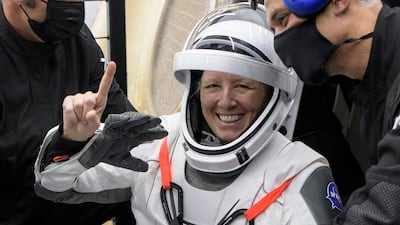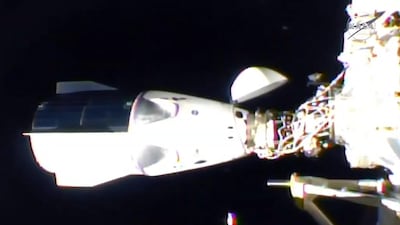In orbit 400 kilometres above the earth and travelling at 7.66 kilometres per second, the International Space Station isn’t the easiest place to park. But on Tuesday morning, SpaceX marked another major milestone in private space flight as its Crew Dragon capsule carrying four astronauts autonomously docked at the research station.
"Dragon SpaceX, soft capture confirmed," said an announcer as the capsule completed its 27.5-hour journey at 4.01 GMT Tuesday, with the second part of the procedure, "hard capture," occurring a few minutes later.
Launched from NASA’s Kennedy Space Centre in Florida’s Cape Canaveral, the SpaceX Falcon 9 powered capsule carrying three US and a Japanese astronaut marked the first manned trip to the ISS from US soil in nearly a decade. A manned flight test earlier this year was the first stage in getting the private company the Nasa green light to start taking crew to the ISS even as it has made several cargo flights to the station in recent years.
“Yesterday was about the raw power of a rocket flinging a capsule,” Anthony Vareha, Nasa Flight Director, tweeted. “Today I get to preside over a ballet – The delicate dance of ‘how do you gently put this capsule at a certain spot within a few millimetres’. It's easy to throw. Catching is harder.”
SpaceX live-streamed the event on Twitter and briefly transmitted live images from inside the capsule showing the astronauts in their seats, something neither the Russians nor the Americans had done before.
Elon Musk, the tech entrepreneur behind SpaceX and car maker Tesla, watched the docking remotely as he suspects he has Covid-19. He tweeted that he “most likely” had a moderate case of the virus.
But the capsule carrying Nasa astronauts Air Force colonel Mike Hopkins, mission pilot Victor Glover, physicist Shannon Walker and Japanese astronaut Soichi Noguchi, was named Resilience – inspired by the project’s determination to continue its mission despite the Covid-19 pandemic.
It was Mr Noguchi’s third trip to space after previously flying on the US shuttle in 2005 and Soyuz in 2009.
Earlier on Tuesday, mission commander Hopkins gave pilot Glover his "gold pin," a Nasa tradition when an astronaut first crosses the 100-kilometre Karman line marking the official boundary of space.
Mr Glover is the first Black astronaut to make an extended stay at the ISS, while Mr Noguchi is the first non-American to fly to orbit on a private spaceship.
The crew joins two Russians and one American aboard the station, and will stay for six months.
Before receiving its flight certification from Nasa last week, SpaceX's Crew Dragon had been under development for roughly a decade, under a public-private Nasa programme started in 2011 to revive the agency’s human space flight capability.
Sunday night’s launch marked SpaceX’s first operational mission for Nasa under that programme, after the rocket company launched and returned an initial test crew of two US astronauts to space last summer.
The Falcon 9 launch vehicle is reusable and at the end of its missions, the Crew Dragon deploys parachutes and then splashes down in the water, just as in the Apollo era.
US President-elect Joe Biden hailed the launch on Twitter as a "testament to the power of science and what we can accomplish by harnessing our innovation, ingenuity, and determination," while President Donald Trump called it "great."
Vice President Mike Pence, who attended the launch with his wife Karen, called it a "new era in human space exploration in America."
SpaceX is scheduled to launch two more crewed flights for Nasa in 2021, including one in the spring, and four cargo-refuelling missions over the next 15 months.
Nasa turned to SpaceX and Boeing after shuttering the checkered Space Shuttle programme in 2011, which failed in its main objectives of making space travel affordable and safe.
The agency will have spent more than $8 billion on the Commercial Crew programme by 2024, with the hope that the private sector can take care of NASA's needs in "low Earth orbit" so it is freed up to focus on return missions to the Moon and then on to Mars.
____________




































